Effect of the Nanotube Radius and the Volume Fraction on the Mechanical Properties of Carbon Nanotube-Reinforced Aluminum Metal Matrix Composites
Abstract
:1. Introduction
2. Results and Discussion
2.1. Tensile Testing and Stress–Strain Curve
2.2. Stress Field and Fracture of Carbon Nanotubes
2.3. Effect of Volume Fraction
2.4. Effect of CNT Radius
2.5. Young’s Modulus
3. Materials and Methods
3.1. Simulation Set-Up
3.2. Interatomic Potential
3.3. Simulation Procedure
4. Conclusions
Funding
Institutional Review Board Statement
Informed Consent Statement
Data Availability Statement
Conflicts of Interest
References
- Uozumi, H.; Kobayashi, K.; Nakanishi, K.; Matsunaga, T.; Shinozaki, K.; Sakamoto, H.; Tsukada, T.; Masuda, C.; Yoshida, M. Fabrication process of carbon nanotube/light metal matrix composites by squeeze casting. Mater. Sci. Eng. A 2008, 495, 282–287. [Google Scholar] [CrossRef]
- Mohammed, S.M.A.K.; Chen, D.L. Carbon Nanotube-Reinforced Aluminum Matrix Composites. Adv. Eng. Mater. 2020, 22, 1901176. [Google Scholar] [CrossRef]
- Wang, H.; Ma, C.; Zhang, W.; Cheng, H.M.; Zeng, Y. Improved damping and high strength of graphene-coated nickel hybrid foams. ACS Appl. Mater. Interfaces 2019, 11, 42690–42696. [Google Scholar] [CrossRef] [PubMed]
- Zhang, S.; Ma, Y.; Suresh, L.; Hao, A.; Bick, M.; Tan, S.C.; Chen, J. Carbon nanotube reinforced strong carbon matrix composites. ACS Nano 2020, 14, 9282–9319. [Google Scholar] [CrossRef] [PubMed]
- Zhang, S.; Nguyen, N.; Leonhardt, B.; Jolowsky, C.; Hao, A.; Park, J.G.; Liang, R. Carbon-nanotube-based electrical conductors: Fabrication, optimization, and applications. Adv. Electron. Mat. 2019, 5, 1800811. [Google Scholar] [CrossRef]
- Chen, M.; Fan, G.; Tan, Z.; Xiong, D.; Guo, Q.; Su, Y.; Zhang, J.; Li, Z.; Naito, M.; Zhang, D. Design of an efficient flake powder metallurgy route to fabricate CNT/6061Al composites. Mater. Des. 2018, 142, 288–296. [Google Scholar] [CrossRef]
- Jiang, L.; Li, Z.; Fan, G.; Cao, L.; Zhang, D. The use of flake powder metallurgy to produce carbon nanotube (CNT)/aluminum composites with a homogeneous CNT distribution. Carbon 2012, 50, 1993–1998. [Google Scholar] [CrossRef]
- Radhamani, A.V.; Lau, H.C.; Ramakrishna, S. CNT-reinforced metal and steel nanocomposites: A comprehensive assessment of progress and future directions. Compos. Part A Appl. Sci. Manuf. 2018, 114, 170–187. [Google Scholar] [CrossRef]
- Choi, H.; Shin, J.; Min, B.; Park, J.; Bae, D. Reinforcing effects of cabon nanotubes in structural aluminum matrix nanocomposites. J. Mater. Res. 2009, 24, 2610–2616. [Google Scholar] [CrossRef]
- Esawi, A.M.K.; Morsi, K.; Sayed, A.; Taher, M.; Lanka, S. Effect of carbon nanotube content on the mechanical properties of CNT-reinforced aluminum composites. Compos. Sci. Technol. 2010, 70, 2237–2241. [Google Scholar] [CrossRef]
- Bakshi, S.R.; Agarwal, A. An analysis of the factors affecting strengthening in carbon nanotube reinforced aluminum composites. Carbon 2011, 49, 533–544. [Google Scholar] [CrossRef]
- Yang, X.; Zou, T.; Shi, C.; Liu, E.; He, C.; Zhao, N. Effect of carbon nanotube content on the properties of in-situ synthesis CNT reinforced Al composites. Mat. Sci. Eng. A 2016, 660, 11–18. [Google Scholar] [CrossRef]
- Suk, M.E. Atomistic behavior of nanoporous carbon nanotube-aluminum composite under compressive loading. Mater. Res. Express 2019, 7, 015028. [Google Scholar] [CrossRef]
- Silvestre, N.; Faria, B.; Lopes, J.N.C. Compressive behavior of CNT-reinforced aluminum composites using molecular dynamics. Compos. Sci. Technol. 2014, 90, 16–24. [Google Scholar] [CrossRef]
- Choi, B.K.; Yoon, G.H.; Lee, S. Molecular dynamics studies of CNT-reinforced aluminum composites under uniaxial tensile loading. Compos. Part. B 2016, 91, 119–125. [Google Scholar] [CrossRef]
- Song, H.-Y.; Zha, X.-W. Influence of nickel coating on the interfacial bonding characteristics of carbon nanotube-aluminum composites. Comp. Mater. Sci. 2010, 49, 899–903. [Google Scholar] [CrossRef]
- Motamedi, M.; Naghdi, A.H.; Jalali, S.K. Effect of temperature on properties of aluminum/single-walled carbon nanotube nanocomposite by molecular dynamics simulation. Proc. Inst. Mech. Eng. Part. C 2019, 234, 635–642. [Google Scholar] [CrossRef]
- Sharma, S.; Kumar, P.; Chandra, R. Mechanical and thermal properties of graphene-carbon nanotube-reinforced metal matrix composites: A molecular dynamics study. J. Compos. Mater. 2016, 5, 3299–3313. [Google Scholar] [CrossRef]
- Shin, S.E.; Choi, H.J.; Shin, J.H.; Bae, D.H. Strengthening behavior of few-layered graphene/aluminum composites. Carbon 2015, 82, 143–151. [Google Scholar] [CrossRef]
- Bartolucci, S.F.; Paras, J.; Rafiee, M.A.; Rafiee, J.; Lee, S.; Kapoor, D.; Koratkar, N. Graphene-aluminum nanocomposites. Mat. Sci. Eng. A 2011, 528, 7933–7937. [Google Scholar] [CrossRef]
- George, R.; Kashyap, K.T.; Rahul, R.; Yamdagni, S. Strengthening in carbon nanotube/aluminum (CNT/Al) composites. Scr. Mat. 2005, 53, 1159–1163. [Google Scholar] [CrossRef]
- Nam, D.H.; Cha, S.I.; Lim, B.K.; Park, H.M.; Han, D.S.; Hong, S.H. Synergetic strengthening by load transfer mechanism and grain refinement of CNT/Al-Cu composite. Carbon 2012, 50, 2417–2423. [Google Scholar] [CrossRef]
- Xu, R.; Tan, Z.; Fan, G.; Ji, G.; Li, Z.; Guo, Q.; Li, Z.; Zhang, D. Microstructure-based modeling on structure-mechanical property relationships in carbon nanotube/aluminum composites. Int. J. Plast. 2019, 120, 278–295. [Google Scholar] [CrossRef]
- Fan, G.; Jiang, Y.; Tan, Z.; Guo, Q.; Xiong, D.-b.; Su, Y.; Lin, R.; Hu, L.; Li, Z.; Zhang, D. Enhanced interfacial bonding and mechanical properties in CNT/Al composites fabricated by flake powder metallurgy. Carbon 2018, 130, 333–339. [Google Scholar] [CrossRef]
- He, C.N.; Zhao, N.Q.; Shi, C.S.; Song, S.Z. Mechanical properties and microstructures of carbon nanotube-reinforced Al matrix composite fabricated by in situ chemical vapor deposition. J. Alloys Compd. 2009, 487, 258–262. [Google Scholar] [CrossRef]
- Ghedjatti, A.; Magnin, Y.; Fossard, F.; Wang, G.; Amara, H.; Flahaut, E.; Lauret, J.-S.; Loiseau, A. Structural Properties of Double-Walled Carbon Nanotubes Driven by Mechanical Interlayer Coupling. ACS Nano 2017, 11, 4840–4847. [Google Scholar] [CrossRef] [Green Version]
- Kutana, A.; Giapis, K.P. Transient Deformation Regime in Bending of Single-Walled Carbon Nanotubes. Phys. Rev. Lett. 2006, 97, 245501. [Google Scholar] [CrossRef] [PubMed] [Green Version]
- Munilla, J.; Castro, M.; Carnicero, A. Surface effects in atomistic mechanical simulations of Al nanocrystals. Phys. Rev. B 2009, 80, 024109. [Google Scholar] [CrossRef]
- Stuart, S.J.; Tutein, A.B.; Harrison, J.A. A reactive potential for hydrocarbons with intermolecular interactions. J. Chem. Phys. 2000, 112, 6472–6486. [Google Scholar] [CrossRef] [Green Version]
- Mishin, Y.; Farkas, D.; Mehl, M.J.; Papaconstantopoulos, D.A. Interatomic potentials for monoatomic metals from experimental data and ab initio calculations. Phys. Rev. B 1999, 59, 3393–3407. [Google Scholar] [CrossRef] [Green Version]
- Haque, M.A.; Saif, M.T.A. Mechanical behavior of 30–50 nm thick aluminum films under uniaxial tension. Scr. Mater. 2002, 47, 863–867. [Google Scholar] [CrossRef]
- Kuo, J.; Huang, I. Extraction of plastic properties of aluminum single crystal using berkovich indentation. Mater. Trans. 2010, 51, 2104–2108. [Google Scholar] [CrossRef] [Green Version]
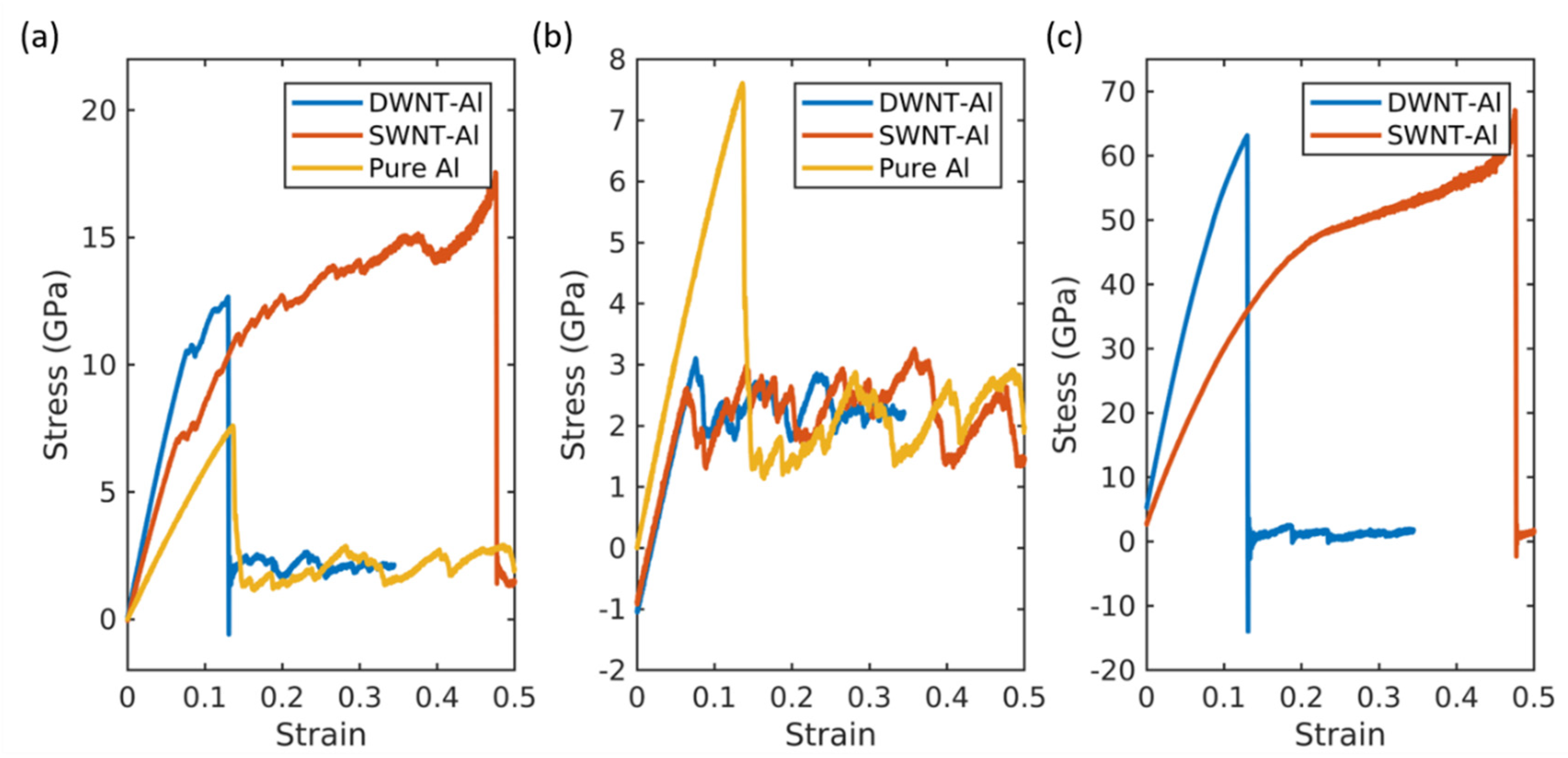

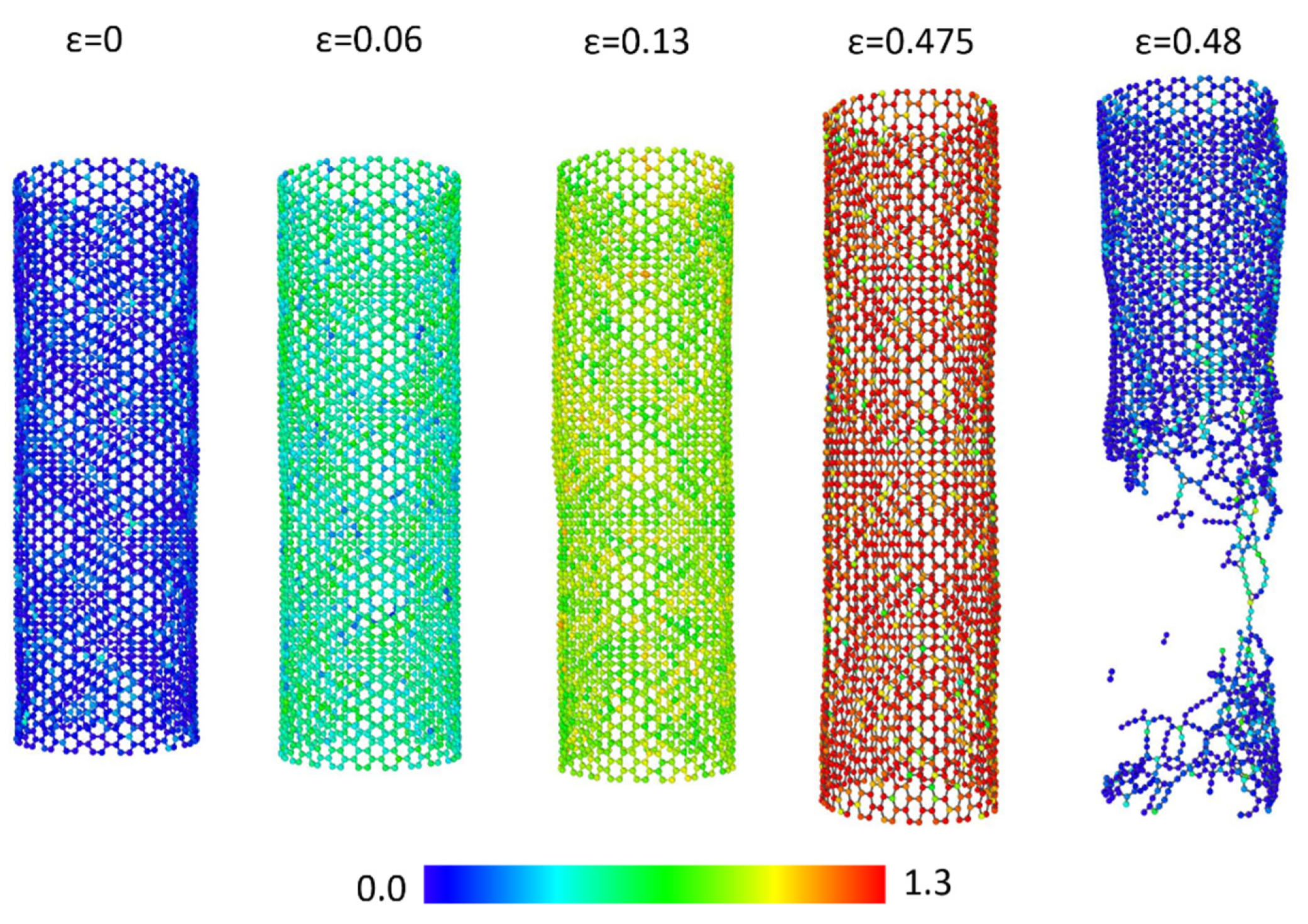
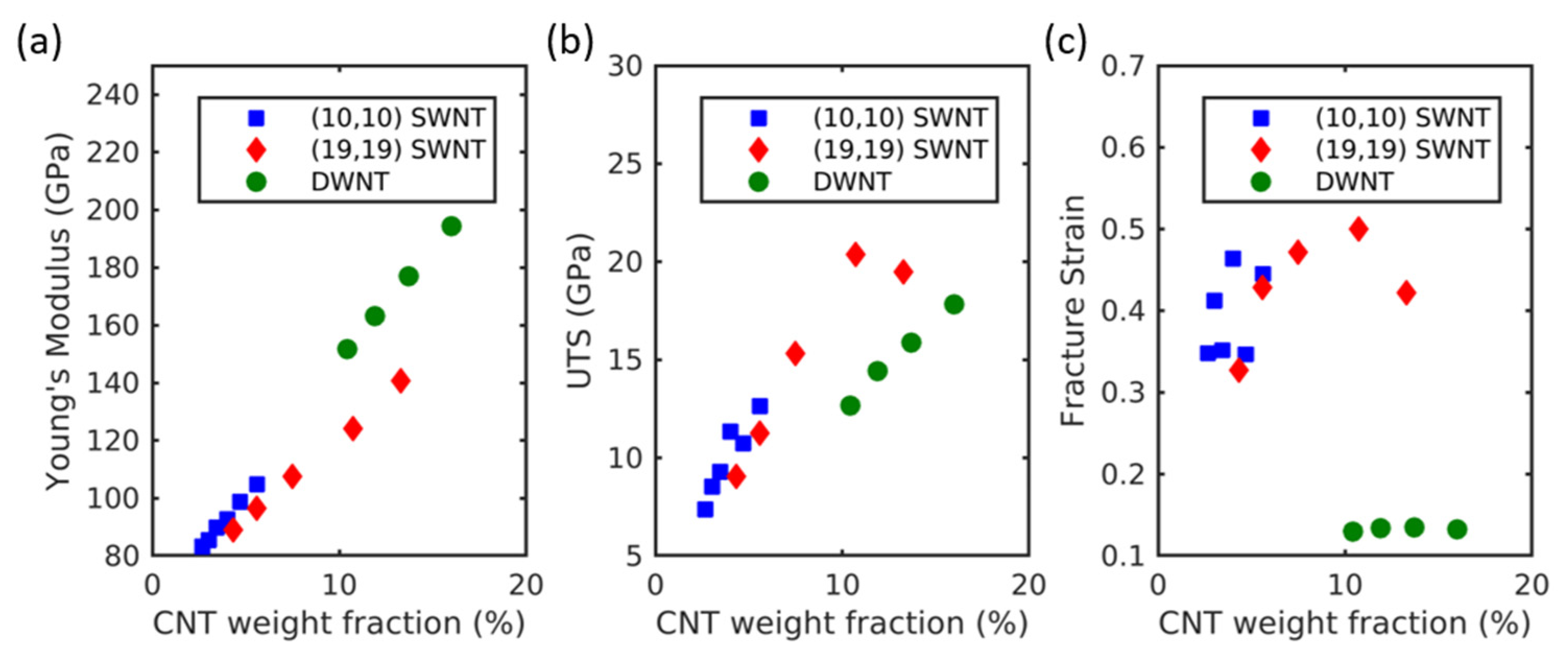
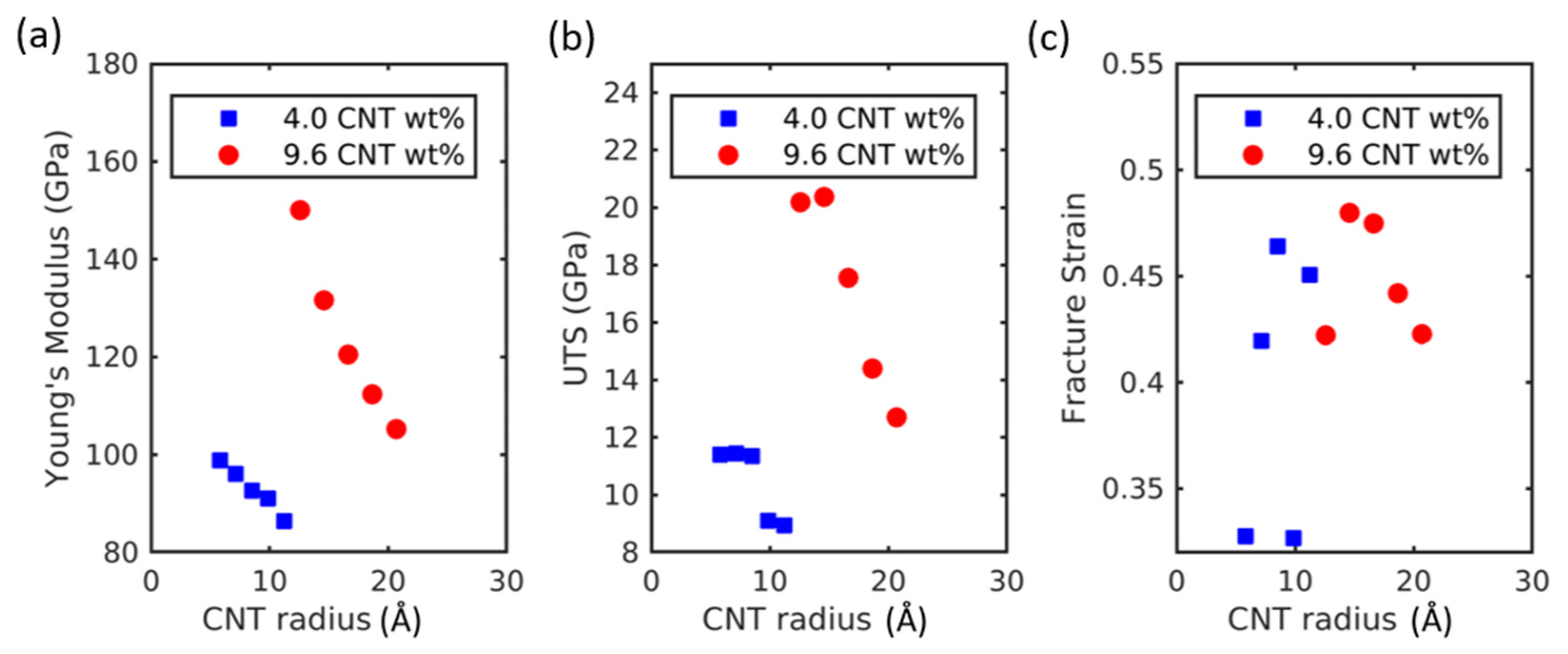
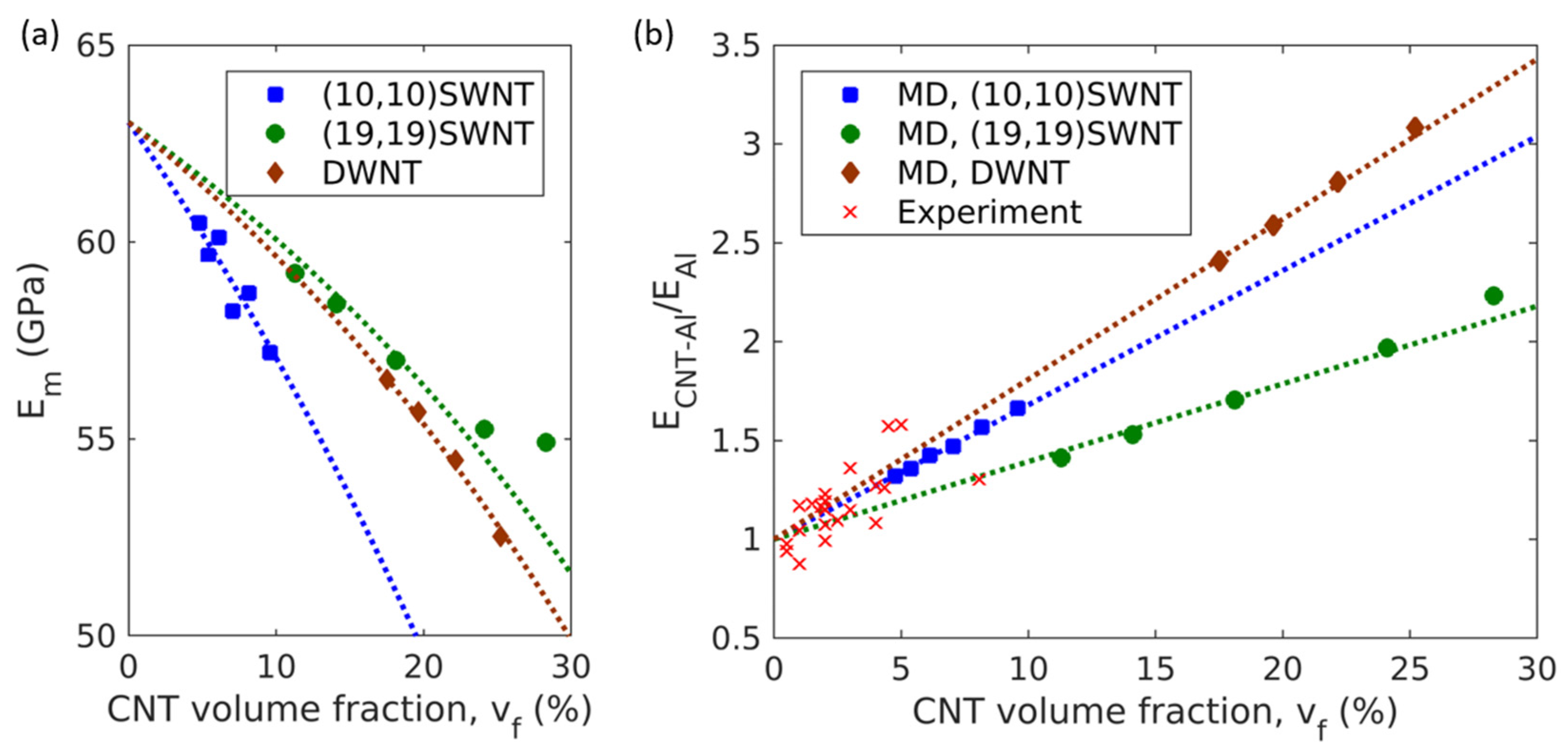
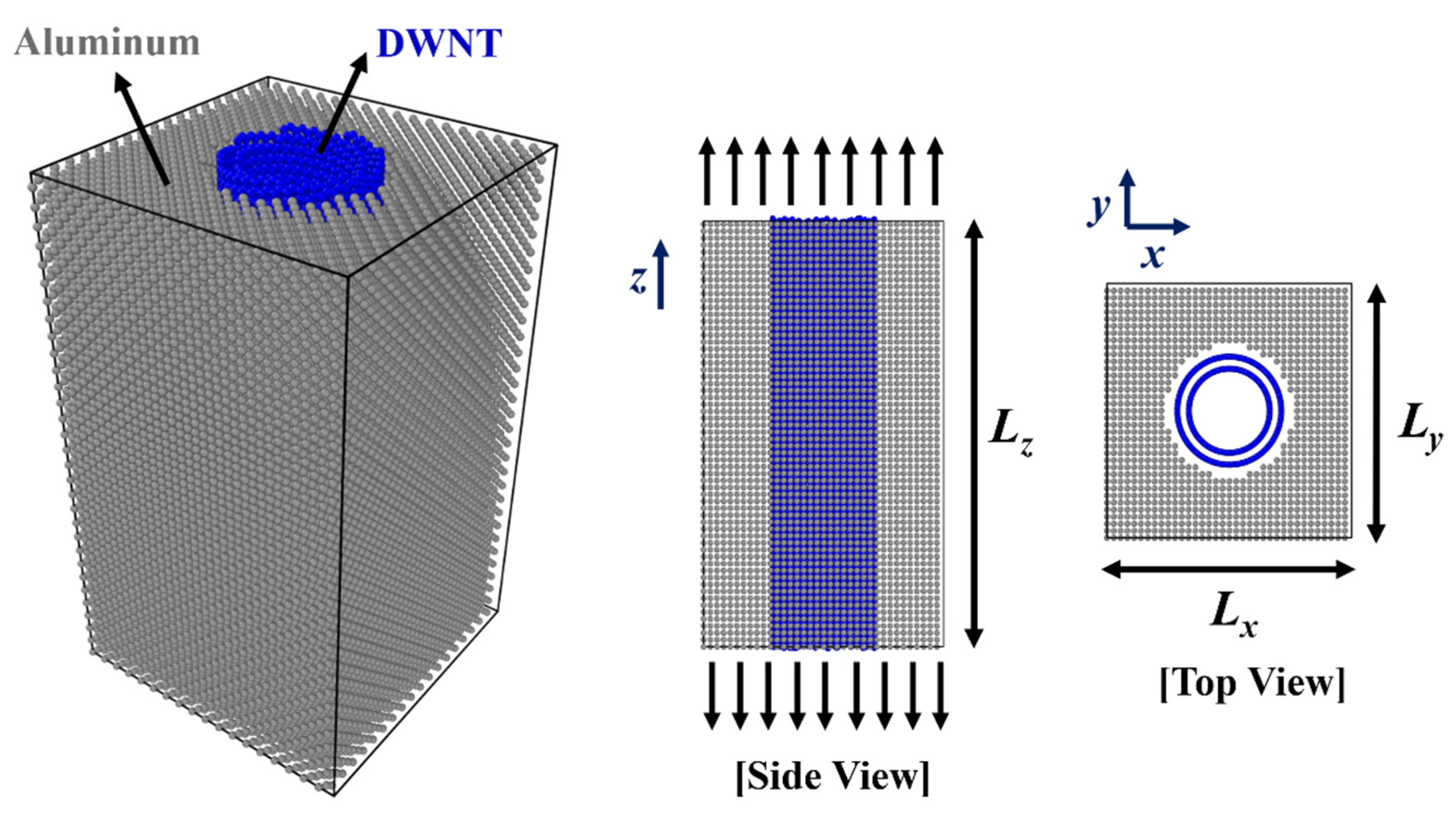
| Inner Radius (Å) | wt% | Young’s Modulus (GPa) | Tensile Strength (GPa) | Fracture Strain | Fracture Toughness (GPa) | |||
|---|---|---|---|---|---|---|---|---|
| CNT-Al MMC | Al-Matrix | CNT | ||||||
| Pure Al | - | - | 62.22 | 7.59 | 0.14 | 0.57 | ||
| DWNT-Al | 17.21 | 10.4 | 151.80 | 56.51 | 600.94 | 12.64 | 0.13 | 1.05 |
| SWNT-Al | 16.6 | 9.14 | 120.49 | 56.83 | 327.61 | 17.54 | 0.48 | 5.57 |
Publisher’s Note: MDPI stays neutral with regard to jurisdictional claims in published maps and institutional affiliations. |
© 2021 by the author. Licensee MDPI, Basel, Switzerland. This article is an open access article distributed under the terms and conditions of the Creative Commons Attribution (CC BY) license (https://creativecommons.org/licenses/by/4.0/).
Share and Cite
Suk, M.E. Effect of the Nanotube Radius and the Volume Fraction on the Mechanical Properties of Carbon Nanotube-Reinforced Aluminum Metal Matrix Composites. Molecules 2021, 26, 3947. https://doi.org/10.3390/molecules26133947
Suk ME. Effect of the Nanotube Radius and the Volume Fraction on the Mechanical Properties of Carbon Nanotube-Reinforced Aluminum Metal Matrix Composites. Molecules. 2021; 26(13):3947. https://doi.org/10.3390/molecules26133947
Chicago/Turabian StyleSuk, Myung Eun. 2021. "Effect of the Nanotube Radius and the Volume Fraction on the Mechanical Properties of Carbon Nanotube-Reinforced Aluminum Metal Matrix Composites" Molecules 26, no. 13: 3947. https://doi.org/10.3390/molecules26133947
APA StyleSuk, M. E. (2021). Effect of the Nanotube Radius and the Volume Fraction on the Mechanical Properties of Carbon Nanotube-Reinforced Aluminum Metal Matrix Composites. Molecules, 26(13), 3947. https://doi.org/10.3390/molecules26133947






